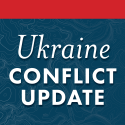Ukraine Conflict Update 8
Feb 25, 2022 - ISW Press
Russian forces entered major Ukrainian cities—including Kyiv and Kherson – for the first time on February 25. Russian forces’ main axes of advance focused on Kyiv, successfully isolating the city on both banks of the Dnipro River. Poorly planned and organized Russian military operations along Ukraine’s northern border have been less successful than those emanating from Crimea so far. Determined and well-organized Ukrainian resistance around Kyiv and Kharkiv has also played an important role in preventing the Russian military from advancing with the speed and success for which it had reportedly planned. The Russian military has deployed forces beyond those it likely planned to use against Ukraine to offset these challenges. However, Russian forces remain much larger and more capable than Ukraine’s conventional military. Russia will likely defeat Ukrainian regular military forces and secure their territorial objectives at some point in the coming days or weeks if Putin is determined to do so and willing to pay the cost in blood and treasure.










